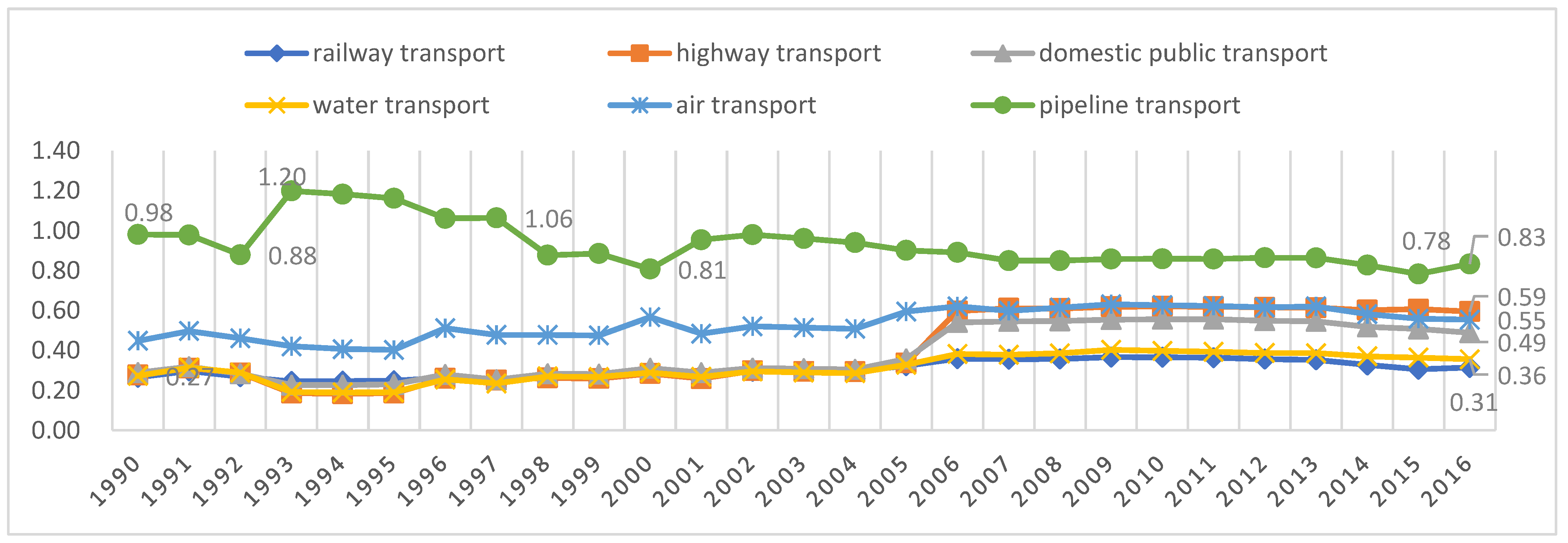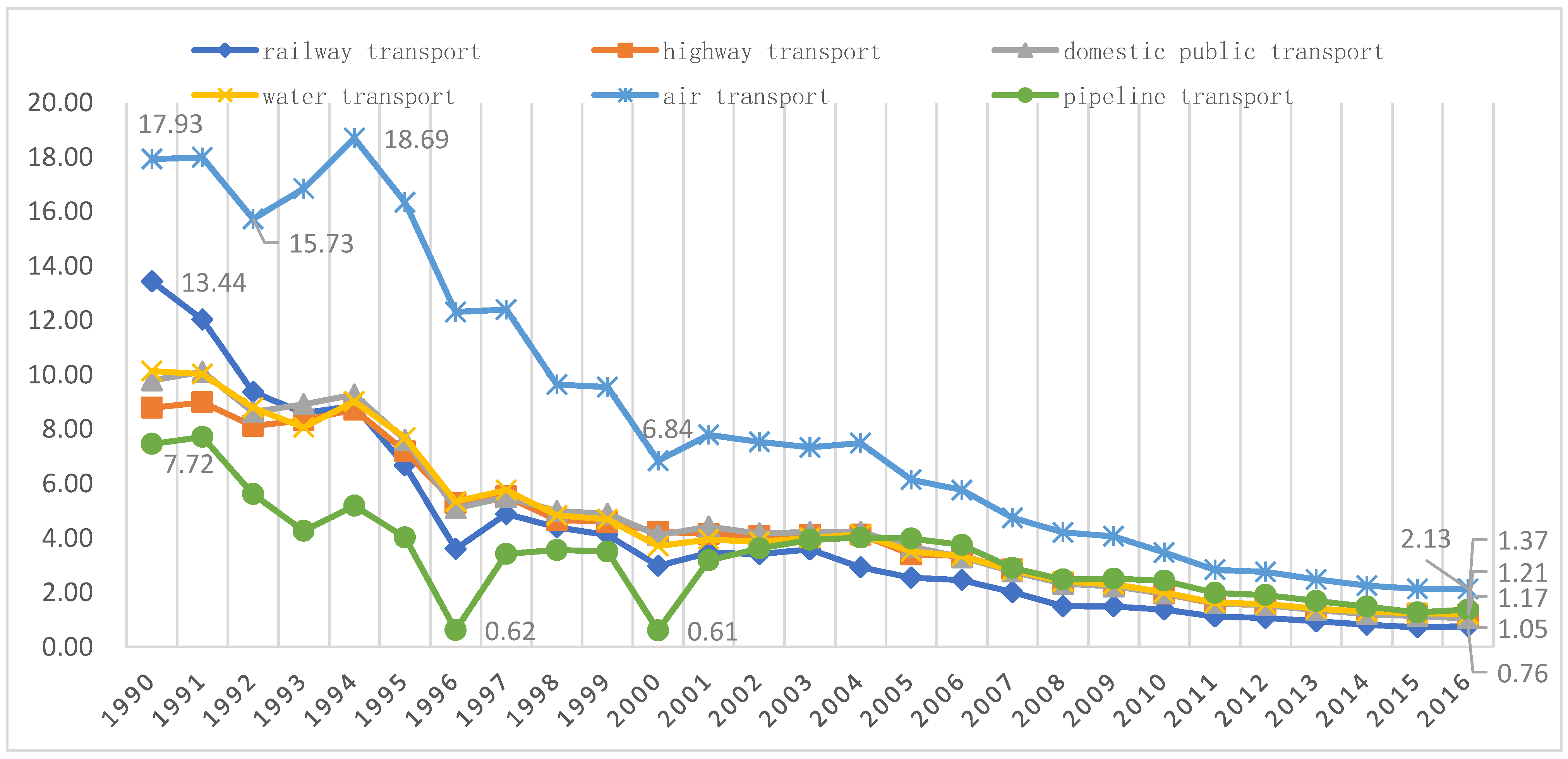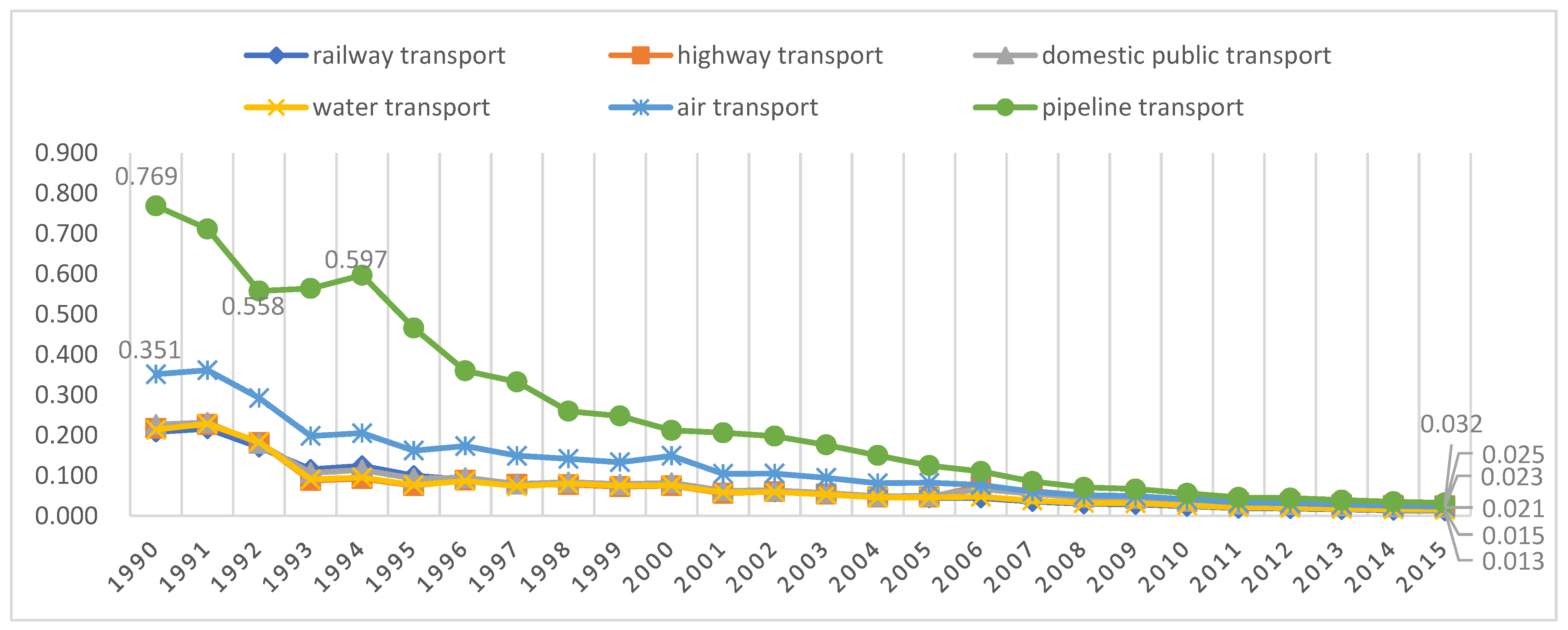The Impact of Transportation Restructuring on the Intensity of Greenhouse Gas Emissions: Empirical Data from China
Abstract
:1. Introduction
2. Methods
2.1. Structure of a Hybrid Input-Output Table
2.2. Noncompetitive Hybrid Input-Output Model
2.3. Determination of the Study Period
2.4. Data Processing
3. Results
3.1. GHG influence Coefficient Analysis
3.1.1. CO2 Influence Coefficient
3.1.2. Non-CO2 GHG Influence Coefficient
3.2. GHG Emission Intensity Analysis
3.2.1. CO2 Emission Intensity Analysis
3.2.2. Non-CO2 GHG Emission Intensity Analysis
3.3. Impact of Transportation Restructuring on GHG Emission Intensity
3.3.1. Impact of Transportation Restructuring on CO2 Emission Intensity
3.3.2. Impact of Transportation Restructuring on the Intensity of Non-CO2 GHG Emissions
4. Discussion
5. Conclusions and Implications
Author Contributions
Funding
Institutional Review Board Statement
Informed Consent Statement
Data Availability Statement
Acknowledgments
Conflicts of Interest
References
- Heidari, H.; Turan Katircioğlu, S.; Saeidpour, L. Economic growth, CO2 emissions, and energy consumption in the five ASEAN countries. Int. J. Electr. Power Energy Syst. 2015, 64, 785–791. [Google Scholar] [CrossRef]
- Watts, N.; Adger, W.N.; Agnolucci, P.; Blackstock, J.; Byass, P.; Cai, W.; Chaytor, S.; Colbourn, T.; Collins, M.; Cooper, A.; et al. Health and climate change: Policy responses to protect public health. Lancet 2015, 386, 1861–1914. [Google Scholar] [CrossRef]
- Haines, A.; McMichael, A.J.; Smith, K.R.; Roberts, I.; Woodcock, J.; Markandya, A.; Armstrong, B.G.; Campbell-Lendrum, D.; Dangour, A.D.; Davies, M.; et al. Public health benefits of strategies to reduce greenhouse-gas emissions: Overview and implications for policy makers. Lancet 2009, 374, 2104–2114. [Google Scholar] [CrossRef]
- Wang, Z.; Zhang, S.; Wu, J. A new RICEs model with the global emission reduction schemes. Chin. Sci. Bull. 2012, 57, 4373–4380. [Google Scholar] [CrossRef] [Green Version]
- IEA. Key World Energy Statistics; IEA: Paris, France, 2012. [Google Scholar]
- Zheng, B.; Zhang, Q.; Borken-Kleefeld, J.; Huo, H.; Guan, D.; Klimont, Z.; Peters, G.P.; He, K. How will greenhouse gas emissions from motor vehicles be constrained in China around 2030? Appl. Energy 2015, 156, 230–240. [Google Scholar] [CrossRef] [Green Version]
- Gan, Y.; Lu, Z.; Cai, H.; Wang, M.; He, X.; Przesmitzki, S. Future private car stock in China: Current growth pattern and effects of car sales restriction. Mitig. Adapt. Strateg. Glob. Chang. 2020, 25, 289–306. [Google Scholar] [CrossRef] [Green Version]
- Wang, H.; Ou, X.; Zhang, X. Mode, technology, energy consumption, and resulting CO2 emissions in China’s transport sector up to 2050. Energy Policy 2017, 109, 719–733. [Google Scholar] [CrossRef]
- Ülengin, F.; Kabak, Ö.; Önsel, Ş.; Ülengin, B.; Aktaş, E. A problem-structuring model for analyzing transportation–environment relationships. Eur. J. Oper. Res. 2010, 200, 844–859. [Google Scholar] [CrossRef] [Green Version]
- Luo, X.; Dong, L.; Dou, Y.; Li, Y.; Liu, K.; Ren, J.; Liang, H.; Mai, X. Factor decomposition analysis and causal mechanism investigation on urban transport CO2 emissions: Comparative study on Shanghai and Tokyo. Energy Policy 2017, 107, 658–668. [Google Scholar] [CrossRef]
- Pan, X.; Wang, H.; Wang, L.; Chen, W. Decarbonization of China’s transportation sector: In light of national mitigation toward the Paris Agreement goals. Energy 2018, 155, 853–864. [Google Scholar] [CrossRef]
- Qiang, Y.; Tian, G.; Liu, Y.; Li, Z. Energy-Efficiency Models of Sustainable Urban Transportation Structure Optimization. IEEE Access 2018, 6, 18192–18199. [Google Scholar] [CrossRef]
- Xia, X.M.; Ma, X.D. Freight structure optimization method based on the industrial structure. In Proceedings of the International Conference on Civil, Architectural and Hydraulic Engineering (ICCAHE 2012), Zhangjiajie, China, 10–12 August 2012; pp. 650–653. [Google Scholar]
- Wang, X.; Zhang, Y. The Impact of High-quality Development of China’s Economy and the Change of Industrial Structure on Energy consumption in Transportation. IOP Conf. Ser. Earth Environ. Sci. 2020, 552, 012013. [Google Scholar] [CrossRef]
- Hou, D.; Li, G.; Chen, D.; Zhu, B.; Hu, S. Evaluation and analysis on the green development of China’s industrial parks using the long-tail effect model. J. Environ. Manag. 2019, 248, 109288. [Google Scholar] [CrossRef]
- Liu, Q.; Chen, Y.; Teng, F.; Tian, C.; Zheng, X.; Zhao, X. Pathway and policy analysis to China’s deep decarbonization. Chin. J. Popul. Resour. Environ. 2017, 15, 39–49. [Google Scholar] [CrossRef]
- Xu, B.; Lin, B. Carbon dioxide emissions reduction in China’s transport sector: A dynamic VAR (vector autoregression) approach. Energy 2015, 83, 486–495. [Google Scholar] [CrossRef]
- Fernández González, P.; Landajo, M.; Presno, M.J. Tracking European Union CO2 emissions through LMDI (logarithmic-mean Divisia index) decomposition. The activity revaluation approach. Energy 2014, 73, 741–750. [Google Scholar] [CrossRef]
- Li, Y.Q.; Zhang, Q. Research on carbon emission reduction based on the optimization of transportation structure under VAR model. In Proceedings of the 5th International Conference on Environmental Science and Material Application (ESMA), Xi’an, China, 15–16 December 2018. [Google Scholar]
- Lin, S.; Wang, J. Carbon emission reduction effect of transportation structure adjustment in China: An approach on multi-objective optimization model. Environ. Sci. Pollut. Res. 2021, 29, 6166–6183. [Google Scholar] [CrossRef]
- Mazzarino, M. The economics of the greenhouse effect: Evaluating the climate change impact due to the transport sector in Italy. Energy Policy 2000, 28, 957–966. [Google Scholar] [CrossRef]
- Roinioti, A.; Koroneos, C. The decomposition of CO2 emissions from energy use in Greece before and during the economic crisis and their decoupling from economic growth. Renew. Sustain. Energy Rev. 2017, 76, 448–459. [Google Scholar] [CrossRef]
- Solaymani, S. CO2 emissions patterns in 7 top carbon emitter economies: The case of transport sector. Energy 2019, 168, 989–1001. [Google Scholar] [CrossRef]
- Mendiluce, M.; Schipper, L. Trends in passenger transport and freight energy use in Spain. Energy Policy 2011, 39, 6466–6475. [Google Scholar] [CrossRef]
- Achour, H.; Belloumi, M. Decomposing the influencing factors of energy consumption in Tunisian transportation sector using the LMDI method. Transp. Policy 2016, 52, 64–71. [Google Scholar] [CrossRef]
- Zhang, S.; Jiang, K.; Liu, D. Energy consumption of China’s transport development and its policy implications. China Soft Sci. 2006, 5, 58–62. [Google Scholar] [CrossRef]
- Weiqi, T.; Wu, L.-B.; Haoqi, Q. From “pollution paradise” to green growth: A study on the regulation and control mechanism of inter-regional transfer of energy-consuming industries. Econ. Res. 2016, 51, 58–70. [Google Scholar]
- Greening, L.A. Effects of human behavior on aggregate carbon intensity of personal transportation: Comparison of 10 OECD countries for the period 1970–1993. Energy Econ. 2004, 26, 1–30. [Google Scholar] [CrossRef]
- Perch-Nielsen, S.; Sesartic, A.; Stucki, M. The greenhouse gas intensity of the tourism sector: The case of Switzerland. Environ. Sci. Policy 2010, 13, 131–140. [Google Scholar] [CrossRef]
- Hao, W.B.; Liu, R.; Jiang, H. Carbon neutrality vs excess methane release from water environments/the methane paradox. Acta Sci. Circumstantiae 2021, 41, 1598. [Google Scholar] [CrossRef]
- Yang, L.; Min-peng, C. Spatial and temporal characteristics of non-carbon dioxide greenhouse gas emissions from agricultural sources in the Yangtze River Economic Belt. China Environ. Sci. 2020, 40, 2039. [Google Scholar] [CrossRef]
- Konan, D.E.; Chan, H.L. Greenhouse gas emissions in Hawaiʻi: Household and visitor expenditure analysis. Energy Econ. 2010, 32, 210–219. [Google Scholar] [CrossRef]
- He, D.; Liu, H.; He, K.; Meng, F.; Jiang, Y.; Wang, M.; Zhou, J.; Calthorpe, P.; Guo, J.; Yao, Z.; et al. Energy use of, and CO2 emissions from China’s urban passenger transportation sector—Carbon mitigation scenarios upon the transportation mode choices. Transp. Res. Part A Policy Pract. 2013, 53, 53–67. [Google Scholar] [CrossRef]
- van Vliet, O.; van den Broek, M.; Turkenburg, W.; Faaij, A. Combining hybrid cars and synthetic fuels with electricity generation and carbon capture and storage. Energy Policy 2011, 39, 248–268. [Google Scholar] [CrossRef]
- Liu, L.; Wang, K.; Wang, S.; Zhang, R.; Tang, X. Assessing energy consumption, CO2 and pollutant emissions and health benefits from China’s transport sector through 2050. Energy Policy 2018, 116, 382–396. [Google Scholar] [CrossRef]
- Yang, F.; Jia, L.; Zhou, Y.; Guan, D.; Feng, K.; Choi, Y.; Zhang, N.; Li, J. Life cycle assessment shows that retrofitting coal-fired power plants with fuel cells will substantially reduce greenhouse gas emissions. One Earth 2022, 5, 392–402. [Google Scholar] [CrossRef]
- Leontief, W. Environmental Repercussions and the Economic Structure: An Input-output Approach. Rev. Econ. Stat. 1970, 52, 262–271. [Google Scholar] [CrossRef]
- Yijun, Y.; Yuanyuan, J. Technical Progress, Changing of Industry Structure and Pollution Abatement Based on the Environmental Input-output Model. J. Ind. Technol. Econ. 2014, 33, 49. [Google Scholar] [CrossRef]
- Alonso-Carrera, J.; Raurich, X. Demand-based structural change and balanced economic growth. J. Macroecon. 2015, 46, 359–374. [Google Scholar] [CrossRef] [Green Version]
- Grossman, G.M.; Krueger, A.B. Environmental Impacts of a North American Free Trade Agreement; National Bureau of Economic Research Cambridge: Cambridge, MA, USA, 1991. [Google Scholar] [CrossRef]
- The State Council of the People’s Republic of China. The 13th Central Committee of the Communist Party of China. Proposal of the Central Committee of the Communist Party of China on Formulating the Ten-Year Plan for National Economic and Social Development and the Eighth Five-Year Plan; Communique of the State Council of the People’s Republic of China: Beijing, China, 1990.
- The State Council of the People’s Republic of China. Ten-Year National Economic and Social Development Plan and the Outline of the “Eighth Five-Year Plan; Communique of the State Council of the People’s Republic of China: Beijing, China, 1991.
- Jinglian, W. A Tutorial on Economic Reform in Contemporary China; Shanghai Far East Publishing House: Shanghai, China, 2016. [Google Scholar]
- Lu, L.; Xuehua, L. A study of industrial structure change and its influencing factors in China. J. Shanghai Adm. Coll. 2020, 21, 97–111. [Google Scholar] [CrossRef]
- Liu, G.; Hao, Y.; Zhou, Y.; Yang, Z.; Zhang, Y.; Su, M. China’s low-carbon industrial transformation assessment based on Logarithmic Mean Divisia Index model. Resour. Conserv. Recycl. 2016, 108, 156–170. [Google Scholar] [CrossRef]
- Chen, L.; Xu, L.; Xu, Q.; Yang, Z. Optimization of urban industrial structure under the low-carbon goal and the water constraints: A case in Dalian, China. J. Clean. Prod. 2016, 114, 323–333. [Google Scholar] [CrossRef]
- Ang, B.W.; Su, B. Carbon emission intensity in electricity production: A global analysis. Energy Policy 2016, 94, 56–63. [Google Scholar] [CrossRef]
- Lane, B.W. On the utility and challenges of high-speed rail in the United States. J. Transp. Geogr. 2012, 22, 282–284. [Google Scholar] [CrossRef]
- Wei, Q.; Zhao, S.; Xiao, W. A Quantitative Analysis of Carbon Emissions Reduction Ability of Transportation Structure Optimization in China. J. Transp. Syst. Eng. Inf. Technol. 2013, 13, 10–17. [Google Scholar] [CrossRef]
- Fan, F.; Lei, Y. Responsive relationship between energy-related carbon dioxide emissions from the transportation sector and economic growth in Beijing—Based on decoupling theory. Int. J. Sustain. Transp. 2017, 11, 764–775. [Google Scholar] [CrossRef]
- West, J.J.; Smith, S.J.; Silva, R.A.; Naik, V.; Zhang, Y.; Adelman, Z.; Fry, M.M.; Anenberg, S.; Horowitz, L.W.; Lamarque, J.-F. Co-benefits of mitigating global greenhouse gas emissions for future air quality and human health. Nat. Clim. Chang. 2013, 3, 885–889. [Google Scholar] [CrossRef] [Green Version]
- Thompson, T.M.; Rausch, S.; Saari, R.K.; Selin, N.E. A systems approach to evaluating the air quality co-benefits of US carbon policies. Nat. Clim. Chang. 2014, 4, 917–923. [Google Scholar] [CrossRef]
- Cai, W.; Hui, J.; Wang, C.; Zheng, Y.; Zhang, X.; Zhang, Q.; Gong, P. The Lancet Countdown on PM2.5 pollution-related health impacts of China’s projected carbon dioxide mitigation in the electric power generation sector under the Paris Agreement: A modelling study. Lancet Planet. Health 2018, 2, e151–e161. [Google Scholar] [CrossRef]
- Solís, J.C.; Sheinbaum, C. Energy consumption and greenhouse gas emission trends in Mexican road transport. Energy Sustain. Dev. 2013, 17, 280–287. [Google Scholar] [CrossRef]
- Hickman, R.; Ashiru, O.; Banister, D. Transitions to low carbon transport futures: Strategic conversations from London and Delhi. J. Transp. Geogr. 2011, 19, 1553–1562. [Google Scholar] [CrossRef]
- Liaquat, A.M.; Kalam, M.A.; Masjuki, H.H.; Jayed, M.H. Potential emissions reduction in road transport sector using biofuel in developing countries. Atmos. Environ. 2010, 44, 3869–3877. [Google Scholar] [CrossRef]
- Kejun, J.; Chenmin, H.; Songli, Z.; Pianpian, X.; Sha, C. Transport scenarios for China and the role of electric vehicles under global 2 °C/1.5 °C targets. Energy Econ. 2021, 103, 105172. [Google Scholar] [CrossRef]




| Input | Intermediate use | Final Use | Gross Output | ||||
|---|---|---|---|---|---|---|---|
| Output | Sector 1 | Sector 2 | … | Sector n | |||
| Intermediate Input | Sector 1 | yi | Xi | ||||
| Sector 2 | |||||||
| … | |||||||
| Sector n | |||||||
| Value Added | vj | ||||||
| Total Input | Xj | ||||||
| GHGs | CO2 | g1j | |||||
| Non-CO2 GHG | g2j | ||||||
| Railway | Highway | Domestic Public | Water | Air | Pipeline | |
|---|---|---|---|---|---|---|
| 1990–1994 | −34.08 | −0.78 | −5.32 | −11.02 | 4.27 | −30.46 |
| 1994–2002 | −61.41 | −53.13 | −54.99 | −57.14 | −59.69 | −30.17 |
| 2002–2009 | −56.49 | −45.42 | −46.65 | −40.30 | −46.08 | −30.76 |
| 2009–2016 | −49.04 | −47.42 | −52.92 | −47.79 | −47.53 | −45.29 |
| 1990–2016 | −94.36 | −86.65 | −89.30 | −88.11 | −88.11 | −81.61 |
| Railway | Highway | Domestic Public | Water | Air | Pipeline | |
|---|---|---|---|---|---|---|
| 1990–1994 | −40.35 | −57.48 | −49.57 | −55.45 | −41.58 | −22.36 |
| 1994–2002 | −51.93 | −34.85 | −44.98 | −37.63 | −48.87 | −66.90 |
| 2002–2009 | −52.32 | −20.13 | −31.50 | −47.37 | −53.31 | −66.29 |
| 2009–2016 | −59.31 | −54.45 | −58.19 | −58.12 | −58.40 | −53.94 |
| 1990–2016 | −94.44 | −89.92 | −92.05 | −93.87 | −94.20 | −96.01 |
| Railway | Highway | Domestic Public | Water | Air | Railway | Nontransportation | |
|---|---|---|---|---|---|---|---|
| 1990–1994 | −24.87 | −52.81 | −57.82 | −73.66 | −66.21 | −50.98 | −5.79 |
| 1994–2002 | 23.03 | 46.48 | 33.94 | 72.18 | 74.06 | 45.40 | 14.18 |
| 2002–2009 | 22.91 | 28.08 | 21.04 | 28.96 | 35.35 | 29.30 | 26.22 |
| 2009–2016 | −12.71 | −13.01 | −13.76 | −15.23 | −18.10 | −17.95 | −16.76 |
| Railway | Highway | Domestic Public | Water | Air | Railway | Nontransportation | |
|---|---|---|---|---|---|---|---|
| 1990–1994 | −2.46 | −5.31 | −6.05 | −4.00 | −4.77 | −5.19 | −0.08 |
| 1994–2002 | 1.68 | 2.97 | 2.67 | 3.44 | 3.73 | 3.70 | 0.66 |
| 2002–2009 | 1.11 | 1.14 | 1.00 | 1.11 | 1.38 | 1.45 | 1.29 |
| 2009–2016 | −0.57 | −0.56 | −0.61 | −0.63 | −0.74 | −0.81 | −0.75 |
Publisher’s Note: MDPI stays neutral with regard to jurisdictional claims in published maps and institutional affiliations. |
© 2022 by the authors. Licensee MDPI, Basel, Switzerland. This article is an open access article distributed under the terms and conditions of the Creative Commons Attribution (CC BY) license (https://creativecommons.org/licenses/by/4.0/).
Share and Cite
Wang, H.; Luo, J.; Zhang, M.; Ling, Y. The Impact of Transportation Restructuring on the Intensity of Greenhouse Gas Emissions: Empirical Data from China. Int. J. Environ. Res. Public Health 2022, 19, 12960. https://doi.org/10.3390/ijerph191912960
Wang H, Luo J, Zhang M, Ling Y. The Impact of Transportation Restructuring on the Intensity of Greenhouse Gas Emissions: Empirical Data from China. International Journal of Environmental Research and Public Health. 2022; 19(19):12960. https://doi.org/10.3390/ijerph191912960
Chicago/Turabian StyleWang, Huiling, Jiaxin Luo, Mengtian Zhang, and Yue Ling. 2022. "The Impact of Transportation Restructuring on the Intensity of Greenhouse Gas Emissions: Empirical Data from China" International Journal of Environmental Research and Public Health 19, no. 19: 12960. https://doi.org/10.3390/ijerph191912960





